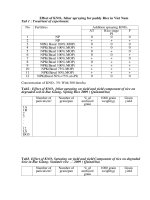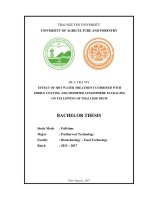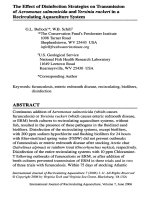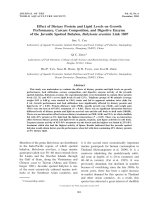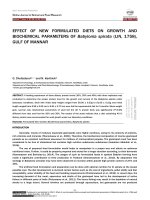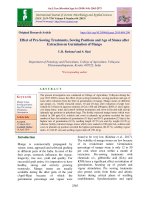Effect of new herbicides and herbicide mixtures on growth and yield of transplanted rice
Bạn đang xem bản rút gọn của tài liệu. Xem và tải ngay bản đầy đủ của tài liệu tại đây (186.99 KB, 7 trang )
Int.J.Curr.Microbiol.App.Sci (2020) 9(7): 2201-2207
International Journal of Current Microbiology and Applied Sciences
ISSN: 2319-7706 Volume 9 Number 7 (2020)
Journal homepage:
Original Research Article
/>
Effect of New Herbicides and Herbicide Mixtures on Growth and Yield of
Transplanted Rice
B. Venkatesh*, Y. S. Parameswari, M. Madhavi and T. Ram Prakash
Department of Agronomy, College of Agriculture, Rajendranagar, Hyderabad-500030,
Professor Jayashankar Telangana State Agricultural University, India
*Corresponding author
ABSTRACT
Keywords
Herbicides,
Transplanted rice,
Growth parameters,
Yield attributes and
Yield
Article Info
Accepted:
20 June 2020
Available Online:
10 July 2020
A field experiment entitled “Effect of new herbicides and herbicide mixtures on growth
and yield of transplanted rice”was conducted during kharif season, 2019 at College farm,
College of Agriculture, Professor Jayashankar Telangana State Agricultural University,
Rajendranagar, Hyderabad to evaluate the effect of different weed management practices
on growth and yield of transplanted rice crop. The soil of the experimental site was sandy
loam in texture, slightly alkaline in reaction, low in organic carbon, low in available
nitrogen, medium in available phosphorus and high available potassium. The experiment
was consisted of twelve treatments (weed management practices) laid out in randomized
block design with three replications. The results revealed that among the different weed
management practices significantly higher plant height, tillers, dry matter production, yield
attributes and yield were recorded with hand weeding at 20 and 40 DAT, which was
statistically on par with flopyrauxifen- benzyl + cyhalofop butyl 10% EC 150 g ha -1 (PoE)
fb hand weeding at 40 DAT, penoxsulam 1.02% (20 g ha-1) + cyhalofop butyl 5.1% OD
(100 g ha-1 ) (PoE) fb hand weeding at 40 DAT and flopyrauxifen- benzyl + penoxsulam
12% EC 40.64 g ha-1 (PoE) fb hand weeding at 40 DAT.
Introduction
Rice (Oryza sativa L.) is the most important
staple food for more than half of the world
population. The warm and humid climatic
conditions are prevailing in most part of Asia
are well suited to rice production. India is the
world second largest producer (105.3 M t)
covering an area of 43.10 m ha with
productivity level of 2.38 t ha-1. However, the
productivity of rice in India is very low
compared to other rice growing countries like
China (7.3 t ha-1), Australia (10.1 t ha-1), U.S
(7.5 t ha-1) and Russia (5.2 t ha-1) (Yadav et
al., 2019). Rice is cultivated in different
ecosystems to increase production levels due
to climate change. Though different
ecosystems are emerging day by day but,
transplanting is the most dominant and
traditional method of rice cultivation under
irrigation. Weeds are the major constraints in
rice production. Transplanted rice is infested
by heterogeneous type of weed flora which
causes yield reduction about 33-45 percent
2201
Int.J.Curr.Microbiol.App.Sci (2020) 9(7): 2201-2207
(Duray et al., 2015). Hand weeding though
efficient, it is expensive, time consuming,
difficult task and often limited by scarcity of
labour at critical period may lead to
unsatisfactory weed control. To get rid this
hurdle usage of herbicides offer a selective
and economical control of weeds right from
beginning of crop.
Due to continuous usage of same mode of
action of herbicides like butachlor,
pretilachlor etc. weed shift is observed in
transplanted rice. Weed shift from grasses to
broad-leaf weeds and sedges were observed in
transplanted rice due to continuous use of
same herbicides (Mohapatra et al., 2017). All
traditional herbicides are narrow spectrum of
control and at the same time dosage of
herbicides is more compare to new low dose
herbicides and pre-mix herbicides and also
cause herbicide residues in soil leads to
environmental pollution. Keeping in this view
the present experiment was conducted to
study the effect of new herbicides and
herbicide mixtures on growth and yield of
transplanted rice.
Materials and Methods
A field experiment was conducted at College
Farm, College of Agriculture Rajendranagar,
Professor Jayashankar Telangana State
Agricultural
University,
Rajendranagar,
Hyderabad during Kharif-2019. The farm is
geographically situated at 17 019' 16.4" North
latitude and 780 24' 43" East longitudes and at
an altitude of 542.3 m above mean sea level.
According to troll’s climatic classification, it
falls under semi- arid tropics (SAT). The soil
of experimental site was sandy loam in
texture with p H of 7.85, low available
nitrogen (235.2), medium phosphorus (38.8)
and high potassium content (379). The
experiment was consisted of twelve weed
management practices laid out in randomized
block design with three replications. RNR –
15048 (Telangana sona) variety was
transplanted in main field on 8 th August at the
age of 28 days old seedlings with a spacing of
15 X 10 cm. All pre-emergence herbicides
were applied within three days after
transplanting and post emergence herbicides
treatments were applied at 2 – 3 leaf stage of
weeds. During crop growing period (July 10 th
to November 17th) a total rainfall of 693.5 mm
received in 45 rainy days. The data on growth
parameters and yield was recorded randomly
selected five plants from net plot. The data
was statistically analysed.
Results and Discussion
Growth parameters
The data related to growth parameters were
significantly influenced by different weed
management practices over un weeded
control. The higher plant height, number of
tillers and dry matter production were
registered with hand weeding at 20 and 40
DAT which was statistically on par with
flopyrauxifen- benzyl + cyhalofop butyl 10%
EC 150 g ha-1 (PoE) fb hand weeding at 40
DAT, penoxsulam 1.02% (20 g ha-1) +
cyhalofop butyl 5.1% OD (100 g ha-1) (PoE)
fb hand weeding at 40 DAT and
flopyrauxifen- benzyl + penoxsulam 12% EC
40.64 g ha-1 (PoE) fb hand weeding at 40
DAT. And these treatments superior over
remaining treatments.
These treatments followed by pyrazosulfuronethyl 0.15 % @ 15 g ha -1 + pretilachlor 6 %
GR @ 600 g ha -1 (PE) fb hand weeding at 30
DAT, orthosulfamuron + pretilachlor 6 % @
600 g ha -1 GR (PE) fb hand weeding at 30
DAT and penoxsulam 0.97 % @ 20 g ha -1 +
butachlor 38.8 % SE @ 820 g ha -1 (PE) fb
hand weeding at 30 DAT and they were on
par with each other. Then followed by
ipfencarbazone 25 % SC @ 156.25 g ha -1
(PE) fb hand weeding at 30 DAT, penoxsulam
2202
Int.J.Curr.Microbiol.App.Sci (2020) 9(7): 2201-2207
2.65 % OD @ 25 g ha -1 (PoE) fb hand
weeding at 40 DAT, bispyribac-sodium 10%
SC 25 g ha -1 (PoE) fb hand weeding at 40
DAT and pretilachlor (PE) 50 % EC @ 0.75
kg ha -1fb 2,4 – D 1.0 kg ha -1 (PoE). Un
weeded control plot recorded significantly
lower plant height, number of tillers and dry
matter production. Among the weed
management
practices
application
of
herbicide mixture fb hand weeding recorded
higher growth parameters compared to single
herbicides fb hand weeding. This might be
due to control of complex weed flora in time
and avoids competition so, resulted in higher
tillers and crop dry matter production. These
results were in line with Yakadri et al., (2016)
and Rana et al., (2018).
Table.1 Effect of new herbicides and herbicide mixtures on growth parameters of transplanted
rice
Treatments
T1 - Penoxsulam 0.97% (20 g ha-1) + butachlor (38.8%) SE 820 g ha-1 (PE) fb
HW at 30 DAT
T2 - Pyrazosulfuron-ethyl 0.15 % (15 g ha-1) + pretilachlor 6% GR (600g ha1
) (PE) fb HW at 30 DAT
T3 - Orthosulfamuron + pretilachlor 6% (600g ha-1) GR (PE) fb HW at 30
DAT
T4 - Ipfencarbazone 25 % SC 156.25 g ha-1 (PE)fb HW at 30 DAT
T5 - Penoxsulam 2.65 % OD 25 g ha-1 (PoE) fb HW at 40 DAT
T6 - Penoxsulam 1.02% (20 g ha-1) + cyhalofop butyl 5.1% OD (100 g ha-1)
(PoE) fb HW at 40 DAT
T7 - Pretilachlor 50 % EC 0.75 kg ha-1(PE) fb 2,4 D 1.0 kg ha-1 (PoE)
T8 - Bispyribac sodium 10% SC 25 g ha-1 (PoE) fb HW at 40 DAT
T9 - Flopyrauxifen- benzyl + penoxsulam 12% EC 40.64 g ha-1 (PoE) fb HW
at 40 DAT
T10 - Flopyrauxifen- benzyl + cyhalofop butyl 10% EC 150 g ha-1 (PoE) fb
HW at 40 DAT
T11 - Hand weeding at 20 and 40 DAT
T12 - Unweeded control
SE(m)±
CD (P=0.05)
2203
Plant
height
(cm)
94.7
No. of
tillers (No.
m -2)
354
Dry matter
(Kg ha -1)
97.0
370
13517
95.8
364
13453
89.7
89.0
100.8
338
330
394
12568
12474
14663
87.7
88.5
99.3
319
326
391
11835
12167
14448
104.5
401
14953
105.0
86.3
2.36
6.93
412
209
7.43
21.8
15014
7732
254.58
746.5
13375
Int.J.Curr.Microbiol.App.Sci (2020) 9(7): 2201-2207
Table.2 Effect of new herbicides and herbicide mixtures onyield attributes and yield of transplanted rice
Treatments
-1
T1 - Penoxsulam 0.97% (20 g ha ) + butachlor (38.8%) SE 820
g ha-1 (PE) fb HW at 30 DAT
T2 - Pyrazosulfuron-ethyl 0.15 % (15 g ha-1) + pretilachlor 6%
GR (600g ha-1) (PE) fb HW at 30 DAT
T3 - Orthosulfamuron + pretilachlor 6% (600g ha-1) GR (PE)
fb HW at 30 DAT
T4 - Ipfencarbazone 25 % SC 156.25 g ha-1 (PE)fb HW at 30
DAT
T5 - Penoxsulam 2.65 % OD 25 g ha-1 (PoE) fb HW at 40 DAT
T6 - Penoxsulam 1.02% (20 g ha-1) + cyhalofop butyl 5.1% OD
(100 g ha-1) (PoE) fb HW at 40 DAT
T7 - Pretilachlor 50 % EC 0.75 kg ha-1(PE)fb 2,4 D 1.0 kg ha-1
(PoE)
T8 - Bispyribac sodium 10% SC 25 g ha-1 (PoE) fb HW at 40
DAT
T9 - Flopyrauxifen- benzyl + penoxsulam 12% EC 40.64 g ha-1
(PoE) fb HW at 40 DAT
T10 - Flopyrauxifen- benzyl + cyhalofop butyl 10% EC 150 g
ha-1 (PoE) fb HW at 40 DAT
T11 - Hand weeding at 20 and 40 DAT
T12 - Unweeded control
SE(m)±
CD (P=0.05)
No of
productive
tillers m -2
325
No. of filled
grains panicle
Grain yield
(kg ha -1)
Straw yield
(kg ha -1)
140
Test
weight
(g)
12.90
5931
7004
334
144
13.00
6016
7045
327
141
13.00
5977
7015
315
130
12.87
5524
6471
313
351
127
157
12.80
13.07
5497
6985
6425
7818
307
122
12.09
5262
6187
308
124
12.80
5333
6282
348
155
13.03
6867
7715
355
161
13.20
7045
7921
356
225
6.04
17.73
162
118
3.73
10.95
13.23
12.40
11.00
NS
7120
3110
146.3
429.0
7992
4219
171.54
503.02
2204
-1
Int.J.Curr.Microbiol.App.Sci (2020) 9(7): 2201-2207
Table.3 Effect of new herbicides and herbicide mixtures on weed density and dry weight at 30 DAT
Treatments
T1 - Penoxsulam 0.97% (20 g ha-1) + butachlor (38.8%) SE 820 g ha-1
(PE) fb HW at 30 DAT
T2 - Pyrazosulfuron-ethyl 0.15 % (15 g ha-1) + pretilachlor 6% GR (600g
ha-1) (PE) fb HW at 30 DAT
T3 - Orthosulfamuron + pretilachlor 6% (600g ha-1) GR (PE) fb HW at
30 DAT
T4 - Ipfencarbazone 25 % SC 156.25 g ha-1 (PE)fb HW at 30 DAT
T5 - Penoxsulam 2.65 % OD 25 g ha-1 (PoE) fb HW at 40 DAT
T6 - Penoxsulam 1.02% (20 g ha-1) + cyhalofop butyl 5.1% OD (100 g ha1
) (PoE) fb HW at 40 DAT
T7 - Pretilachlor 50 % EC 0.75 kg ha-1 (PE) fb 2,4 D 1.0 kg ha-1 (PoE)
T8 - Bispyribac sodium 10% SC 25 g ha-1 (PoE) fb HW at 40 DAT
T9 - Flopyrauxifen- benzyl + penoxsulam 12% EC 40.64 g ha-1 (PoE) fb
HW at 40 DAT
T10 - Flopyrauxifen- benzyl + cyhalofop butyl 10% EC 150 g ha-1 (PoE)
fb HW at 40 DAT
T11 - Hand weeding at 20 and 40 DAT
T12 - Unweeded control
SE(m)±
CD (P=0.05)
** Values in the parenthesis are original and (√x+1) transformed
2205
Weed density
(No. m-2)
4.5(19.0)
Weed dry
weight (g m-2)
3.9 (14.5)
4.1(15.7)
3.8 (13.3)
4.4(18.3)
3.9 (14.0)
4.7(21.0)
5.0(23.7)
3.3 (9.7)
4.2 (16.8)
4.3 (18.0)
2.9 (7.4)
5.1(25.0)
5.0(24.3)
3.3(10.0)
4.5 (19.2)
4.4 (18.6)
2.9 (7.7)
3.1 (8.7)
2.7 (6.3)
2.8 (7.3)
8.7(74.0)
0.18
0.53
2.6 (6.0)
8.2 (65.7)
0.17
0.51
Int.J.Curr.Microbiol.App.Sci (2020) 9(7): 2201-2207
Yield attributes and yield
Yield attributes and yield significantly
influenced by different weed management
practices. Higher number of productive tillers
m -2, number of filled grains panicle -1, grain
and straw yield were registered with hand
weeding at 20 and 40 DAT which was
statistically on par with the flopyrauxifenbenzyl + cyhalofop butyl 10% EC 150 g ha-1
(PoE) fb hand weeding at 40 DAT,
penoxsulam 1.02% (20 g ha-1) + cyhalofop
butyl 5.1% OD (100 g ha-1) (PoE) fb hand
weeding at 40 DAT and flopyrauxifen- benzyl
+ penoxsulam 12% EC 40.64 g ha-1 (PoE) fb
hand weeding at 40 DAT. These treatments
followed by pyrazosulfuron-ethyl 0.15 % @
15 g ha -1 + pretilachlor 6 % GR @ 600 g ha -1
(PE) fb hand weeding at 30 DAT,
orthosulfamuron + pretilachlor 6 % @ 600 g
ha -1 GR (PE) fb hand weeding at 30 DAT and
penoxsulam 0.97 % @ 20 g ha -1 + butachlor
38.8 % SE @ 820 g ha -1 (PE) fb hand
weeding at 30 DAT and which were superior
over remaining treatments. Then followed by
ipfencarbazone 25 % SC @ 156.25 g ha -1
(PE) fb hand weeding at 30 DAT, penoxsulam
2.65 % OD @ 25 g ha -1 (PoE) fb hand
weeding at 40 DAT, bispyribac-sodium 10%
SC 25 g ha -1 (PoE) fb hand weeding at 40
DAT and pretilachlor (PE) 50 % EC @ 0.75
kg ha -1fb 2,4 – D 1.0 kg ha -1 (PoE). Un
weeded control plot recorded significantly
lowernumber of yield attributes and yield.
Weed management practices not only reduce
weed density and dry matter allows the plant
to use available resources which resulted in
higher growth parameters and yield attributes
ultimately led to higher yield over un weeded
control. Similar reports were by Chowdhary
and Dixit (2018), Singh et al., (2019) and
Ramesha et al., (2019).
Weed density and weed dry weight
weight at 30 DAT, was observed with hand
weeding at 20 and 40 DAT and which was
statistically comparable to the flopyrauxifenbenzyl + cyhalofop-butyl 10% EC 150 g ha 1
(PoE)fb hand weeding at 40 DAT,
penoxsulam 1.02% @ 20 g ha -1 + cyhalofop
butyl 5.1 % OD @ 100 g ha -1 (PoE) fb hand
weeding at 40 DAT and flopyrauxifen-benzyl
+ penoxsulam 12 % EC @ 40.64 g ha -1
(PoE)fb hand weeding at 40 DAT. These
treatments followed pyrazosulfuron-ethyl
0.15 % @ 15 g ha -1 + pretilachlor 6 % GR @
600 g ha -1(PE) fb hand weeding at 30 DAT,
orthosulfamuron + pretilachlor 6 % @ 600 g
ha -1 GR (PE)fb hand weeding at 30 DAT and
penoxsulam 0.97 % @ 20 g ha -1 + butachlor
38.8 % SE @ 820 g ha -1(PE)fb hand weeding
at 30 DAT were recorded lower total weed
density and weed dry weight than rest of
treatments. Then followed by ipfencarbazone
25 % SC @ 156.25 g ha -1(PE)fb hand
weeding at 30 DAT, penoxsulam 2.65 % OD
@ 25 g ha -1 (PoE)fb hand weeding at 40
DAT, bispyribac-sodium 10% SC 25 g ha 1
(PoE)fb hand weeding at 40 DAT and
pretilachlor (PE) 50 % EC @ 0.75 kg ha -1fb
2,4 – D 1.0 kg ha -1 (PoE) were on par with
each other. Higher weed density and weed dry
weight was recorded with un weeded control
over all the treatments. Lower weed density in
different weed management practices might
be due to effective control of weeds Hossain
and Mondal (2014) and Yadav et al., (2019b).
In conclusion the hand weeding twice 20 and
40 DAT, Post emergence (2- 3 leaf stage of
weeds) application of herbicide mixtures
flopyrauxifen- benzyl + cyhalofop butyl 10%
EC 150 g ha-1, Penoxsulam 1.02% (20 g ha-1)
+ cyhalofop butyl 5.1% OD (100 g ha-1) and
flopyrauxifen- benzyl + penoxsulam 12% EC
40.64 g ha-1 along with hand weeding at 40
DAT were effective in influencing of growth
parameters, yield attributes and yield of
transplanted rice.
Lower total weed density and total weed dry
2206
Int.J.Curr.Microbiol.App.Sci (2020) 9(7): 2201-2207
References
Choudhary, V.K and Dixit, A. 2018.
Herbicide weed management on weed
dynamics, crop growth and yield in
direct-seeded rice. Indian Journal of
Weed Science. 50(1): 6-12.
Duary, B., Teja, K. C and Soren, U. 2015.
Management of composite weed flora
of
transplanted
rice
by
herbicides. Indian Journal of Weed
Science. 47(4): 349-352.
Mohapatra, S., Tripathy, S.K., Nayak, B.R
and Mohanty, A.K. 2017. Efficacy of
pre-emergence herbicides for control
of complex weed flora in transplanted
rice. Indian
Journal
of
Weed
Science. 49 (3): 216-218.
Ramesha, Y. M., Anand, S. R.,
Krishnamurthy, D and Bhanuvally, M.
2019. Weed management effect to
increase grain yield in dry directseeded rice. Indian Journal of Weed
Science. 51(1): 6-9.
Rana, A., Rana, M. C., Rana, S. S., Sharma, N
and Kumar, S. 2018. Weed control by
pyrazosulfuron-ethyl and its influence
on yield and economics of transplanted
rice. Indian
Journal
of
Weed
Science. 50(4): 309-314.
Singh, K., Singh, S and Pannu, R. K. 2019.
Efficacy of pendimethalin and
cyhalofop-butyl+ penoxsulam against
major grass weeds of direct-seeded
rice. Indian Journal of Weed Science.
51 (3): 227-231.
Yadav, D. B., Singh, N., Duhan, A., Yadav, A
and Punia, S. S. 2019. Penoxsulam
influence on weed complex and
productivity of transplanted rice and its
residual effects in rice-wheat cropping
system. Indian Journal of Weed
Science. 51(1): 10-14.
Yakadri, M., Madhavi, M., Ramprakash, T
and Rani, L. 2016. Herbicide
combinations for control of complex
weed flora in transplanted rice. Indian
Journal of Weed Science. 48 (2): 155157.
How to cite this article:
Venkatesh, B., Y. S. Parameswari, M. Madhavi and Ram Prakash, T. 2020. Effect of New
Herbicides and Herbicide Mixtures on Growth and Yield of Transplanted Rice.
Int.J.Curr.Microbiol.App.Sci. 9(07): 2201-2207. doi: />
2207
